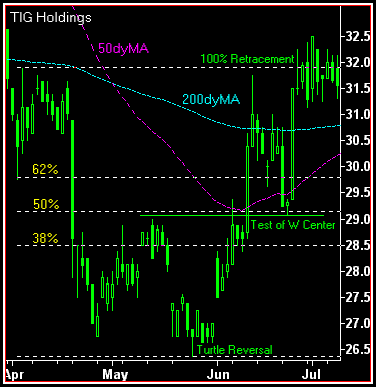This rally fades and price descends back toward a
test of the last bottom low. At this moment the trader listens closely for the first bell
to ring. A wide range reversal bar (doji or hammer) may appear close to the low price of
the last bottom. Or volume spikes sharply but price does not fail. Better yet, a Turtle
Reversal develops where price violates the last low by a few ticks and then prints
a sharp move back above support. Should any or all of these events occur, we mark the
potential second leg on our Big W.
Trade entry can be initiated aggressively near the bottom of the
second leg if the bells ring loudly. The top of the shorter move marking the partial
retracement of the last downward impulse (middle of the W) now becomes our main pivot
price for analysis and further trade entry. For price to successfully return to this
point, it must retrace 100% of the last fall (from the second low). This finally breaks
the lower high, lower low bear cycle. In strong DBs, price will quickly surge to this
price right off the second bottom.
A less aggressive long position can be entered when this new
impulse retraces strongly through 62% of the fall into the second low. However, if a
short-term exit is desired, sufficient profit potential must exist between the entry and
the pivot price for this trade to make sense. Longer-term traders can hold positions as
price mounts this pivot. At this point, it will often pause to test support. However,
another upward leg is then expected.
Price returning to the height of the middle of the Big W has a
very high probability of surging beyond this point. Under normal conditions, it can easily
retrace 100% of the original downward impulse, completing both the DB and Big W patterns.
This tendency allows for further entry at the expected return test to the pivot point
after the second surge has begun. The TIG chart provides an excellent example of this
second chance opportunity.

In 1996, property-casualty carrier TIG Holdings charted a double
bottom volatility ride uncommon in insurance stocks. As price emerged from a small but
powerful Turtle Reversal, it faithfully completed a classic double bottom variation: the
outline of the letter W.
